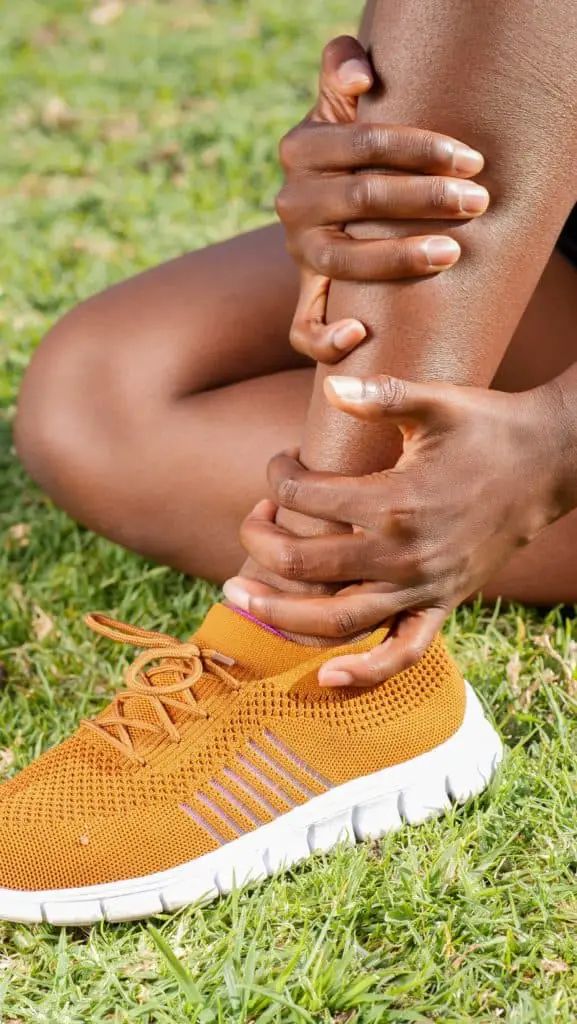
Cramps = a common and annoying ailment. Leg cramps, aka Charley Horses, the most common variety, can stop you in your tracks. The older you get, the more susceptible you are to cramping. Is that bottle of pickle juice the remedy for leg cramps?
Some cramp sufferers insist that nothing knocks out a cramp quite like pickle juice. Does it logically follow that older adults should keep a bottle of the briny beverage available at all times? And does it matter what kind of pickle juice you drink to remedy cramps? Read on to learn more about cramps and how anyone of any age might deal with them.
Pickle juice is something I suggested to my incredulous, workaholic hair stylist of 10 years. He had just announced he was cutting back his work hours. Why? Because he had a cramp so severe during the night, he fell and hurt his back. Falling is one of the hazards when a sudden cramp or Charlie horse takes hold. You can’t walk, you can’t stand up. You are incapacitated.
I suggested to the stylist that he take a teaspoon of mustard – or gulp pickle juice the next time he has an attack. He looked at me as though I had completely lost it. But pickle juice IS a remedy for cramps. As is mustard, used by marathoners who carry packets of it with them when they run.
What Are Cramps?
A cramp is an involuntary muscular contraction strong enough to hurt. Some cramps last only a few seconds, and others continue for several minutes. It feels like a muscle has knotted up. Sometimes, with a leg cramp, the leg will spasm. Even after the cramping lessens, pain in the affected area can continue for hours.
Some people describe cramps as painful but harmless. While they aren’t a medical emergency, it’s an exaggeration to call them harmless. They can interfere with your sleep and may disrupt your exercise routine. They can diminish your quality of life, lead to apprehension and mental distress, and may cause you to fall.
At the very least, if you’re walking, gardening, or playing with your grandchildren, they might cause you to stop doing something that you enjoy.
What Causes Cramps?
Ruling out any muscular or nerve degenerative disease, like ALS, the immediate cause of cramps is often muscle overuse, dehydration or just being stuck in one position. Cramps are associated with a lack of potassium, calcium, sodium or magnesium. Some medications such as blood pressure meds can deplete these minerals. People with diabetes, nerve, liver, or thyroid disorders are more susceptible to cramps.
But one of the biggest risk factors for cramping is simply aging.

Cramps and Seniors
According to Dr. Robert Miller, a neurologist at California Pacific Medical Center, whose specialty is muscle cramps, older people are at greater risk for cramps simply because of their age. “Nerves control muscles and nerves just wear out.
As we age, there are changes in both nerves and muscles. Muscles get weaker and smaller. And nerves undergo some decay, with the tissue becoming thin. And when that happens, the connections that the nerves make to the muscle become less secure.
Cramps occur at the place where nerves meet muscle”, says Miller. When the brain sends the signal for the muscle to move, “the signal does have to cross through tiny nerve twigs or nerve terminals. Excessive signaling, excessive irritability — which may result from thinning and weakened nerves — seems to be the generator for cramping”.
Cramps often occur at night. Up to 60 percent of adults get leg cramps at night, and nearly every person over 50 has them occasionally. About 33 percent of folks over age 60 have at least one cramp every two months. Cramps are more common in women than in men.
Cramps can wake you with a jolt of pain and keep you awake with post-cramp soreness. A leg cramp when you’re active during the daytime can cause a fall. Even when they don’t directly lead to falling, they can contribute to sleeplessness, fatigue, and a less active lifestyle. All of these conditions exacerbate the risk for falls and fractures.
In summary, cramps are more than just an annoyance. They should be taken seriously, and you should do what you can to mitigate their frequency.
What To Do About Cramps
The best way to deal with cramps is not to have them in the first place. There are several foods that replenish essential minerals and may reduce the risk of cramping. These include bananas, sweet potatoes, avocados, legumes, melons, nuts, salmon and tomatoes. Fast-acting Pickle juice is also touted as a preventative as well as a cramp slayer; more on that below.
If you do have cramps, some of the following might afford some immediate relief.
- Stretching. Try straightening and flexing the affected leg, including flexing the toes. (Stretching as a preventative is encouraged, especially before retiring for the evening).
- Movement. If you’re sitting, stand up. Flatten your feet against the ground. If you’re standing, walk. Wiggle your leg as you go.
- Heat or cold. Apply a heating pad or cool the area with ice or a freezer pack. Some people alternate hot and cold.
- Elevation. You may not be able to do this right away, but it can help reduce the ongoing pain after the cramp subsides.
There’s no reason to delay stretching until cramps are actually present. A stretching routine, either daily or stretching specifically before exercise, can diminish the risk of cramps.

Non-Traditional Remedies: Pickle Juice and Mustard
Pickle juice does seem to work as a cramp remedy, although no one is sure exactly why. Call it pickle power because studies show that pickle juice reduces the duration of a cramp. Some people think the salt and vinegar in pickle juice help to replenish electrolytes. Other research indicates that the juice sets off a reaction in the nervous system.
Endurance cyclists have long espoused high-saline foods such as pickles, pickle juice, certain tomato-based vegetable juices, and even potato chips as cramping preventatives. At the very least, they make you feel better if you suffer the effects of extended exertion on a hot day.
Other endurance athletes such as marathoners believe that mustard prevents cramping, even carrying packs of the condiment on their runs. The science around this hypothesis is uncertain. Mustard does contain sodium and potassium, but possibly not in the quantities required to make a difference.
Some have posited that since mustard contains turmeric, which is noted for its anti-inflammatory properties, it may relax muscles and relieve cramps. Others suggest that mustard activates sensors in the back of the throat which in turn send out a signal that calms the nerves in muscles.
Why Not Use Pickle Juice as a Remedy for Leg Cramps?
While we wait for the scientists to sort out why remedies such as pickle juice and mustard can be effective, here’s a practical suggestion: try it. You have nothing to lose, and if you discover that it works, use it. Keep it by your bedside as I do. But in the meantime, don’t neglect other traditional anti-cramping measures such as diet, stretching, and an active lifestyle.
Everyone is different, and good health results from a combination of factors. Our bodies change as we age, and an increased risk of cramping is, unfortunately, part of the package. We will have to make continued adjustments if we want to continue to enjoy health and fitness into old age. Pickle juice and mustard might be two simple interventions to help us get there.
